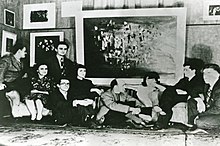Les Automatistes

Les Automatistes were a group of
The movement may have begun with an exhibition Borduas gave in Montreal in 1942. Held at the Ermitage, an exhibition hall owned by the Collège de Montréal, the show featured gouaches that illustrated the artist's experimentation with non-figurative painting.[1] Initially, les Automatistes exhibited in makeshift venues, since no commercial gallery was willing to show the work of all the members.[1] However, the group was soon being exhibited in Paris and New York also. Though it began as a visual arts group, it also spread to other forms of expression, such as drama, poetry and dance. The title "les Automatistes" came from journalist Tancrède Marcil Jr., in a review of their second exhibit in Montreal (February 15 to March 1, 1947), which appeared in Le Quartier Latin (the Université de Montréal's student journal).
In 1948,
Alongside Lyrical Abstract painters in France, the Automatistes favoured a fluid, painterly technique over the comparatively reserved, hard-edge abstraction so popular in the U.S. and Eastern Europe at the time. Much like a nonobjective Group of Seven, they were looking to create a distinctively Canadian artistic identity. Heavily influenced by Surrealist manifestos and poetry, their work was largely stream-of-consciousness inspired, believing this to be a truer means of communicating subconscious emotions and sensory experiences; they wanted to be liberated from intention, reason, and any kind of structure, in order to communicate a universal human experience without bias. This resulted in increasingly crude or intuitive methods such as applying paint with palette knives and fingers and painting blindfolded, their efforts contradicting their claims of working without intention.[2]
Media
In 1954, the Automatistes were the subject of the NFB/CBC documentary series On the Spot in an episode entitled Artist in Montreal.[3]
See also
References
- ^ ISBN 978-1-4871-0014-8.
- ^ Nasgaard, Roald; Ellenwood, Ray (2009). The Automatiste Revolution. Vancouver, BC: D&M Publishers Inc.
- ^ Ohayon, Albert (April 14, 2010). "On the Spot: The NFB in the early days of television". NFB.ca. National Film Board of Canada. Retrieved April 15, 2010.
External links
- Text of Le Refus global (in French)
- The Automatists and the Book by Michel Brisebois on Le Refus global as a printed book.
- CBC Digital Archives – Le Refus global: Revolution in the Arts
- Artist in Montreal a 1954 National Film Board of Canada documentary
- Time Article on Borduas and Le Refus global
- Total Refusal (Refus Global): the manifesto of the Montréal Automatists, translated by Ray Ellenwood. Holstein, Ont: Exile Editions, 2009. ISBN 9781550961072
- Ellenwood, Ray. Egregore : a history of the Montréal automatist movement. Toronto: ISBN 9781550960211
- Nasgaard, Roald. The Automatiste revolution : Montreal, 1941–1960. Vancouver: Douglas & McIntyre, 2009. ISBN 9781553653561
